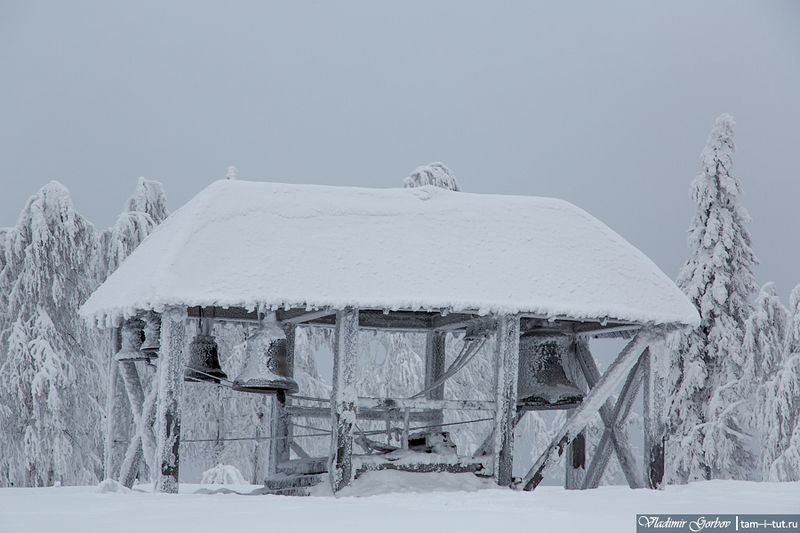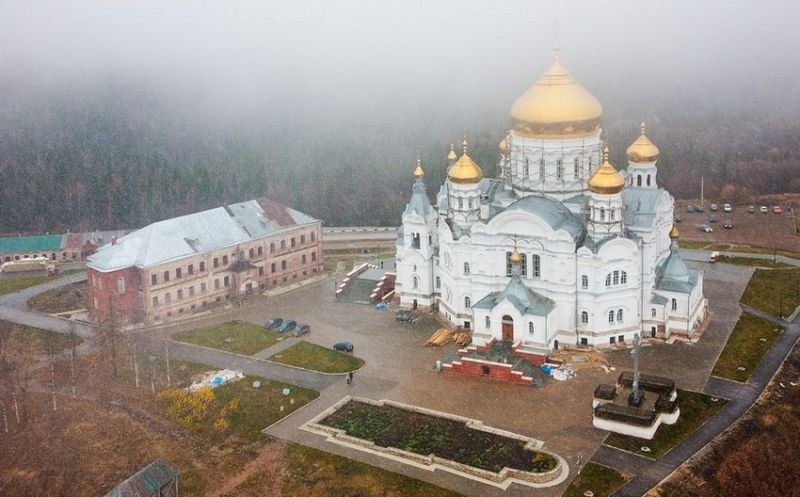The Belogorsky Monastery of St. Nicholas, also known as the Belaya Gora Monastery, is located on top of a hill in Belaya Gora or the White Mountains, in Russia, at a distance of 85 kilometers from the city of Perm and about 50 kilometers away from the town of Kungur. The monastery is dominated by a beautiful white church with gold onion domes topped by golden crosses. During winter through spring, the white structure becomes indistinguishable from the snowy surrounding.
The original wooden church and monastery was built in 1894, and housed some 25 orphan boys who received education in reading, writing, church singing and various crafts. When the building burned down, construction of a new, two-story, stone church began in June 1902, and it went on for the next fifteen years. During those years some four hundred monks lived within the grounds, and they helped in the monastery's construction by making their own bricks at the monastery’s brickworks. They also practiced agriculture, animal husbandry, bee-keeping and fishing.

Photo credit: Vadim Balakin
When the monastery was completed in 1917, it had room for 8,000 people and was equipped with ventilation and a steam heating system. Inside the church, the high, arcing ceiling, and walls were covered with classical Russian Orthodox paintings and icons of saints and religious scenes accentuated with gold. Its official consecration ceremony was attended by around 30,000 people. The Belogorsky Monastery's Cathedral became Perm diocese's most grandiose church.
Then one day in 1918, the Bolsheviks arrived at the monastery, dragged the monastery's Archimandrite Varlaam to the valley below, shot him and threw him in the Kama River. They broke the great bells of the monastery with sledge hammers and destroyed many artworks. Many monks lost their lives trying to prevent the monastery’s destruction. Some were lined up against the church walls and shot —the bullet holes still evident in the walls. Others were buried alive in mass graves. Many were deported.
In the 1930s, the monastery’s buildings were used as a prison camp for the politically repressed and the forcibly relocated, and later a home for the disabled was opened. During the Second World War, it became a rehabilitation center for the wounded and the crippled in the war. It served as the house for invalids and the mentally unstable until 1986. In 1980, a mental patient almost brought the entire building down when he set fire to the roof. The cathedral was badly damaged and almost all the cathedral’s domes were burnt.
In 1993, work began to restore the building and has been going on ever since. The final phase of the restoration began in 2011.

Photo credit: pravperm.ru

Photo credit: vladomir.livejournal.com

Photo credit: vladomir.livejournal.com

Photo credit: sergpodzoro.livejournal.com

Photo credit: Vadim Balakin

Photo credit: Vadim Balakin

Photo credit: Vadim Balakin

Photo credit: Vladimir Chuprikov

Photo credit: vladomir.livejournal.com

Photo credit: vladomir.livejournal.com

A replacement for a smaller wooden version that once stood here commemorating the survival of Nicholas II, after he was attacked by a sword-wielding assassin in Japan in 1891. Photo credit: vladomir.livejournal.com

Photo credit: sergpodzoro.livejournal.com

Photo credit: sergpodzoro.livejournal.com

Photo credit: sobory.ru
Sources: Orthodox Wiki / WorldTalk.info / www.railway-train-travel.com.au / Wild Blue Press / Wikipedia



Comments
Post a Comment